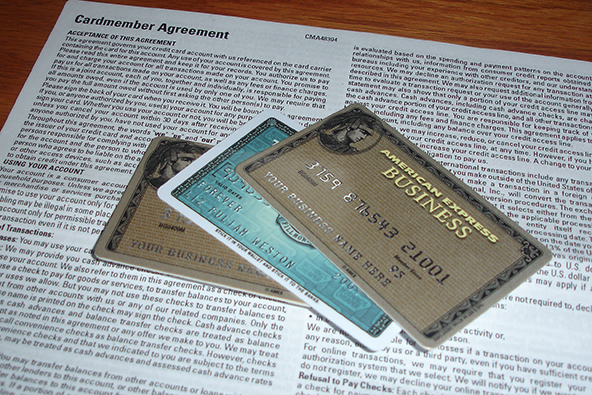Do You Understand Your New Credit Card Agreement?

Last week we wrote about the U.S. Consumer Financial Protection Bureau’s ongoing crusade aiming to simplify credit card agreements, even as the CFPB’s own survey had found that consumers reported to be fairly satisfied with how the current, post-CARD Act, version is presenting the terms and conditions of these contracts.
As promised, the CFPB has now released its vision of a “shorter, simpler credit card agreement” and has posted it on its website for comments. Well, having reviewed CFPB’s version and compared it to a generic agreement, my conclusion is that it is neither shorter, nor simpler, although it is made to look that way. Let me explain.
CFPB’s Proposed Agreement
The bureau has split the credit card agreement into two separate parts. The first one lists the terms and conditions of the contract, which runs into two pages and I think that most Americans who have ever applied for credit cards will find it familiar.
The second part of the agreement consists of definitions of the terms used in the contract, listed in an alphabetical order. It runs into six pages, extending the total length of the agreement to eight pages, although it is presented as not being a part of the agreement.
Now let’s see how the proposed version compares to a currently used generic agreement.
CFPB vs. American Express
You can find generic versions of the agreements used by U.S. banks on CFPB’s website here. I picked the agreement used by American Express Bank, FSB, because this is one of the biggest U.S. issuers and I’m pretty sure it is fairly representative for the field.
The first observation is that the AmEx agreement, just like the CFPB’s, is split into two separate parts. The first one contains the terms and conditions and the second — titled “Supplement to the Cardmember Agreement” — provides explanations of terms, as well as a description of the associated rewards program.
Both agreements run into eight pages, even though the CFPB version does not have to describe a rewards program, which takes about a page of AmEx’s. So CFPB’s agreement is in fact a page longer than AmEx’s.
But has the CFPB managed to simplify the agreement? Well, let’s look at how the agency’s version explains the way interest is calculated:
How is interest calculated?
We calculate interest using the daily balance method with compounding. This means that interest compounds daily.
We will not charge you interest on purchases if you pay your full account balance by the due date each month. This is called a grace period. If you do not take advantage of the grace period, we will charge interest starting the day you make a purchase. If you do not pay your full account balance on time in any month you will lose your grace period until you pay your full account balance on time x months in a row. You pay interest on cash advances or balance transfers from [date].
Here is how AmEx has done it:
We use the Average Daily Balance method (including new transactions) to figure interest charges for each balance. The total interest charged for a billing period is the sum of the interest charged on each balance.
Interest
The interest charged for a balance in a billing period, except for variations caused by rounding, equals:
- Average Daily Balance (ADB) x
- Daily Periodic Rate (DPR) x
- number of days the DPR was in effect.
ADB
To get the ADB for a balance, we add up its daily balances. Then we divide the result by the number of days the DPR for that balance was in effect. If the daily balance is negative, we treat it as zero.
DPR
A DPR is 1/365th of an APR, rounded to one tenthousandth of a percentage point. Your DPRs are shown in How Rates and Fees Work on page 2 of Part 1.
I can’t find anything particularly novel in CFPB’s proposal. People will still need to look up what prime rate means and will still need to learn how to calculate compound interest, if they want to know what their interest payments will be.
Let’s take another example, this one informing cardholders when they have to make payments. First, CFPB:
We will send your bill to the address on file. You agree to pay all authorized charges on the bill, including interest and fees. You agree to pay us for charges that we allow over your credit limits. You must pay at least the minimum payment by the due date stated on each bill. Your minimum payment will be [insert formula].
Now AmEx:
You must pay at least the Minimum Payment Due by the Payment Due Date. The Minimum Payment Due and Payment Due Date are shown on each billing statement.
Each statement also states the time and manner by which you must make your payment for it to be credited as of the same day it is received. For your payment to be considered on time, we must receive at least the Minimum Payment Due in such time and manner by the Payment Due Date shown on your billing statement.
Once again, there is no difference. I can go on, but you get the idea.
The Takeaway
The point is that the CARD Act did a pretty good job at simplifying credit card agreements, as consumers have already told the CFPB. It is true that some terms are still not well understood, but I don’t think that any amount of explanation will change that.
In fact, the CFPB may be in agreement with me on that last point. For example, its proposed agreement refers to the compound interest rate in its explanation of how interest is calculated (see quote above), but it does not even attempt to explain it. I can understand why. The only way to do so in a meaningful way would involve a formula — A = P(1 + r/n)nt — and I would bet you $10,000 (sorry Mitt Romney) a quarter that most Americans would find this confusing and would accuse the offending card issuer (or the CFPB, for that matter) of using math to hide the truth.
So yes, the CARD Act has already succeeded in simplifying and shortening credit card agreements and the CFPB is wasting government resources in its attempt to do it all over again.
Image credit: Asklizweston.com.



I made a comment on an earlier post arguing that you were confusing agreements and statements. You’ve made it a little better, but you still talk about the CARD Act improving agreements, which is not supported by your own link.
And I think you missed the point of the whole exercise, at least as I understand it. Right now, an AmEx consumer would get 8 pages as opposed to 2. The CFPB doesn’t want issuers to send the standard definitions. Consumers could look up terms if they want to but they don’t have to worry because they are standard terms given by the CFPB. While AmEx might hide things in the fine print, consumers could reasonably trust the CFPB to not trick them. So CFPB consumers get 2 pages and can trust everything else. That seems like a real difference.
Instead of tilting at windmills, I think you should ask the real question: what if the CFPB can’t be trusted? What if there was a bad practice hidden in a “standard” definition? That makes me worried.